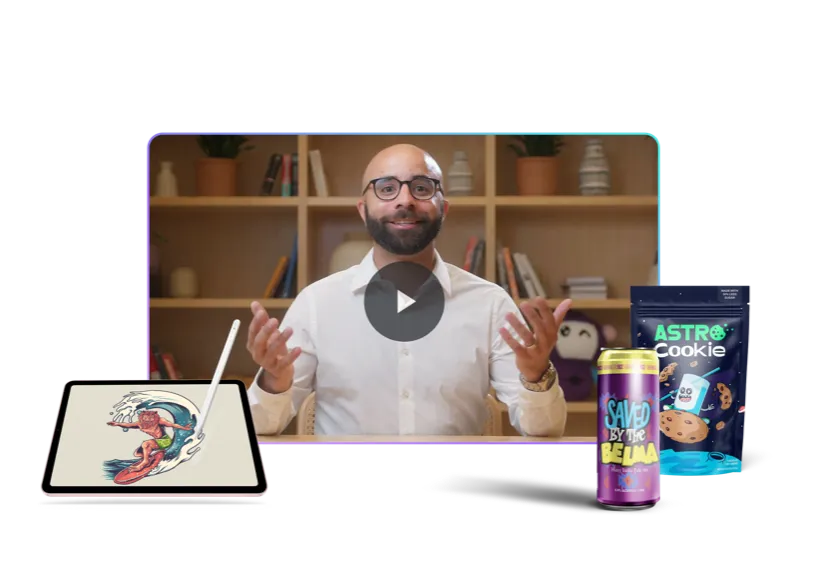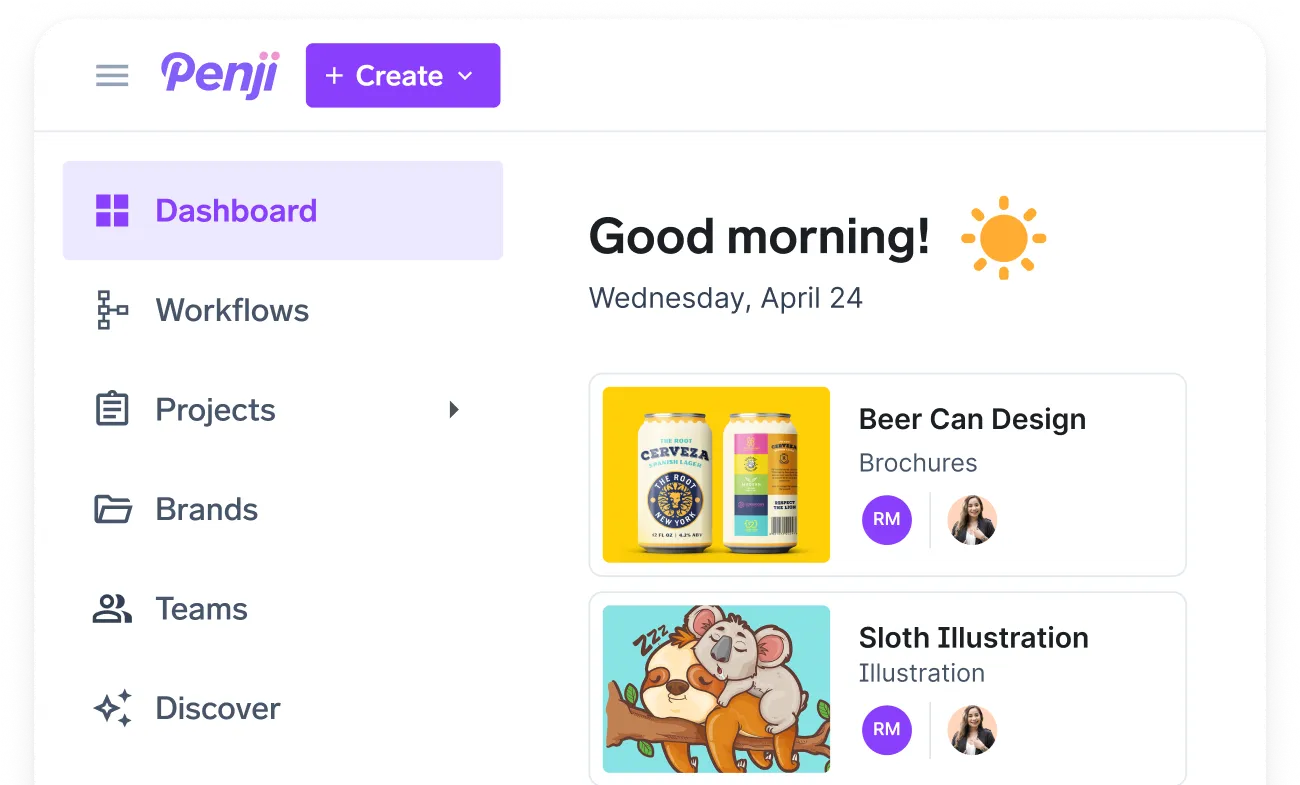![[Fully Managed] Kevin Roy from Green Banana SEO Ep. 126](https://penji.co/wp-content/uploads/2025/07/BLOG-IMAGE-Kevin-Roy.jpg)
Shannon: Hello, everyone, and welcome to the Fully Managed Podcast, a podcast where we discuss marketing and business tips to help assist you on your business journey. I’m your host, Shannon, Penji’s Partnership Coordinator, and I’m joined today with Kevin Roy from Green Banana SEO. Thank you so much for coming on with me today.
Kevin: Thanks for having me. I appreciate it.
Kevin’s Origin Story
Shannon: So could you start by telling us a little bit about how you got to this point? What inspired you to co-found Green Banana SEO and anything in between that you think is important?
Kevin: I guess it was necessity. I’ve been doing this for a long time—this is year seventeen. I bought my business partner out about a year and a half ago. But I was working for an internet startup as the marketing person, and I got fortuitously pushed into the web department. They let me take coursework at MIT and paid for it, so it was a really great opportunity.
Then the company got bought, and I was the last person left running the web. They got bought by a huge company, so they didn’t really need another web person. They were handing out severance packages. I took a severance package, bought a computer with the money they gave me, and then went to three people that I knew and said, “I’ll build you a website for free. Just do me a favor and don’t tell anybody it was free. If you like it, tell people. If you don’t like it, don’t tell anybody.”
That’s what started it, and then I did a lot of networking. We’ve been on the Inc 5000 three times, but it was a long road to that.
Transition from Web Design to SEO
Shannon: That’s an incredible journey. It’s also really interesting to go from web design to SEO. I know they’re obviously involved, but how did you decide to center yourself around SEO?
Kevin: Well, first, SEO is a huge component of what we do—it’s a part of it. We do full-scale digital marketing. We run tons of Google ads, meta, LinkedIn, TikTok, geofencing, GR targeting—basically anything you see on a screen.
The reason we got into SEO was when we started building websites, if you’ve ever done a website project, it never ends the day you think it’s going to end. It’s like building a house—almost any project doesn’t have a perfect timeline. If you’re working with an owner and they have to answer another call or skip your meeting, those things just happen.
We were having trouble paying the bills, not because we weren’t getting enough business, but because we weren’t finishing jobs on time for millions of reasons. We couldn’t predict when a job was going to finish. Even if a client wanted something done at a certain time, they would take three weeks to approve the design, and the project would be three weeks out.
So we started to do SEO. I started learning SEO and got super into it. To this day, I still spend probably a hundred hours a year studying SEO from people that are smarter than me.
Shannon: That’s interesting to get into another sector that’s also unpredictable in a way for timeline purposes.
Kevin: But it’s residual. The great thing about digital marketing is you get monthly checks. Building websites is like flipping houses. Doing SEO or digital marketing is like lawn maintenance—you get a good contract, you do a good job, and you can stack those on to each other.
The Birth of Pay-for-Performance SEO
Shannon: When you started doing SEO, did you from the beginning do the pay-for-performance strategy, or is that something you implemented later on?
Kevin: When we started doing SEO, we did it like everybody else—time and materials. The pay-for-performance SEO came out of a meeting I had years ago when we had a client we’d done some web work with. They were a great client and asked us to do SEO, so we did the on-page development, links, map optimizations—all the things we were supposed to do for SEO.
I spent all night working on this beautiful presentation and brought it into a boardroom. One of these people opened my presentation that I was super excited about, and the owner of the company said, “So what are we paying you for again?” I was like, “You’ve got to be kidding me. You’re paying me for all this SEO stuff that I’m doing.”
I realized they didn’t understand anything we were doing. They don’t know what latent semantic indexing is, they don’t know what metadata is. They think I’m just making stuff up. The only reason they didn’t think I was making stuff up is because they trusted me already, but they didn’t know what they were paying for.
So I said, “How about this? I get you on page one. I know I can rank you for these keyword phrases. If I rank you, you pay me. If I don’t rank you, you don’t pay me. But I’m never doing this thing again—I’m not doing another report and I’m not coming in to talk about everything we did. If that works for you, great. If it doesn’t, then let’s continue on the path we’re on.”
They were like, “Great, let’s do it.” I left the office, walked into my business partner’s office when I got back and said, “I either did something really good or I completely screwed up and I’m not really sure what it is.”
How Pay-for-Performance Works
Kevin: The only difference between pay-for-performance and regular SEO is literally we charge you if we rank you for the keywords that you pick. If we rank you, you pay. If we don’t rank, you don’t pay. We still have to do all the stuff we did before for SEO because you have to follow the rules. You have to write good content, do interlinking, make sure the site’s not broken, do good external links.
With pay-for-performance, we just report the ranks. We don’t spend any time telling the client what we’re doing—not because we don’t want to, but because we priced it in such a way that we’re going to get you ranked, we’re going to do all the work internally. If we rank you, you pay. If we don’t rank, you don’t pay.
We can’t do any shady stuff. If we do black hat stuff and you lose your rankings, we can’t collect paychecks. We can’t do that.
We do have about twenty percent of our clients now who want weekly reports and want to meet with us on a regular basis. Those people we don’t do pay-for-performance for.
Shannon: So it’s like an exceptional thing.
Kevin: Yeah, so pay-for-performance is our largest base—most people do that. But our larger clients, like some Fortune 500 clients, think pay-for-performance is kitschy. They want to see the pretty report, they want to talk about our press release link building strategy. So we do the same thing but we’re doing a lot more face time with the client.
Building Trust and Confidence
Shannon: That makes a lot of sense. It’s nice to offer that because it shows confidence in your work. And I think people are more likely to trust you. But it’s also nice to offer both avenues because you still have all this data that you can update them with. It’s just that people don’t care most of the time, as long as they’re seeing results.
Kevin: Right. Most small local businesses don’t care. All they have to worry about is getting ranked for the stuff they want and making sure you’re not doing shady stuff. Pay-for-performance kind of covers both.
Most Difficult SEO Challenges
Shannon: What do you think is the most difficult field or subject for SEO specifically? Do you think there’s a specific area that’s particularly challenging?
Kevin: I always get this curiosity question because I know answers are always different. It’s not really the industry—it’s the keywords. So imagine if you have biotech clients. If you want to rank for “T7 DNA ligase,” there’s not a lot of competition out there. There’s still competitors, but it’s not like ranking for “dating.”
If someone has a brand new site and they want to rank for “auto insurance,” good Lord, think about how much content and all the people you’re going up against. But it’s not just the company size, it’s the keyword.
One of my favorite examples is Moby Dick. Imagine if you wanted to rank page one, number one for “Moby Dick.” That’s not really competitive in terms of business—people aren’t flying around trying to sell Moby Dick books. But there’s millions and millions of articles written about it. There’s movies about it, there’s IMDB, there’s Amazon, there’s all this content on that book. It’s going to be really hard to rank for that because you have to make your page more relevant and have more relevant links than everybody else.
So it’s not just the industry. It’s more the keyword.
Keyword Strategy and Client Education
Shannon: Do you ever get a client that comes to you looking to rank for a keyword, but you have experience with clients in that field that you know that probably won’t gain them traffic?
Kevin: Oh, yeah. There’s a couple of solutions for that. If a client comes to us with a keyword they really want to rank for that doesn’t get a lot of traffic, the first thing we’re going to ask them is, “Why do you want to rank for this keyword?”
We live in the Northeast, and we have a client that does heated driveways. It’s crazy expensive to build and insanely expensive every time there’s a snowstorm. So there’s not a lot of people that have heated driveways, you can imagine. The search volume is super low. But we have a client that ranks for it. All they care about—if they get one job every two years, it’s like three hundred thousand dollars for a job. And they’re not paying a lot to get that keyword ranked because it’s really easy to rank.
But if someone comes in and says, “I want light pink shingles in Topeka, Kansas, and I think I’m going to make a fortune off of it,” we’ll be like, “Okay, you might not want to pick that keyword.”
Another thing we work with clients on—some clients come to us and say, “Hey, I really want to rank. I want to do an SEO project with you. I’m not sure what keyword phrases I want to commit to.” We say, “Let’s do a Google AdWords program because I can get you on page one tomorrow in Google Ads. If you outbid everybody else, you can rank guaranteed in Google AdWords. If that keyword drives you business, then it’s a good keyword to optimize. If that keyword doesn’t get you anything, it’s probably not a good keyword for you.”
We talk to people a lot about using AdWords as a great discovery to try to see whether SEO for certain keywords is going to work or not.
Building Long-term Client Relationships
Shannon: That’s really helpful because if someone does come to you with a keyword that you don’t think will work, you can show them evidence of why you feel that it won’t bring them traffic.
Kevin: Right. And you’re going through the process together and saying to the client, “Hey, I don’t want to just rank you for some garbage that you’re going to have to pay me for and feel bad about it. Let’s help your business succeed.”
Honestly, as we’ve been doing this longer and longer, the best thing to do is get a client that’s going to work with you and help that client succeed because they grow into bigger clients. Getting someone trapped in an SEO campaign that they don’t want, that they’re unsure about in the beginning—it’s going to be a crappy relationship. It’s no fun for your employees, it’s no fun for you, no fun for them. So it’s better to just find stuff that works.
The Importance of Trust and Transparency
Shannon: It’s honorable that you’re willing to do that with them rather than just go with what they’re asking for, because a lot of people don’t know anything about SEO and they just think this will work because this is what they want or this makes sense to them, and it just does not make sense. You have the knowledge—they’re coming to you because they want to know more, but a lot of people are hesitant or don’t trust people. So it’s nice to be able to see the evidence, but also you don’t want to take advantage of the fact that they don’t know as much.
Kevin: Yeah. And honestly, if anyone listening does SEO or digital marketing, the people that hire you don’t know how to do it. That’s why they’re hiring you. So they don’t know what it is anyway. So it’s really important to give them as much information that will make them comfortable and give them as many options that will do that. And that’s how it will grow. Our best clients are the clients we have the best relationships with. Those are the ones where those campaigns surprisingly work better than anything else because they’re giving us as much feedback as we’re giving them. It’s helping them grow.
Shannon: That’s beautiful. The more trust and transparency that an agency has with a client, both ways too, because there are a lot of times where a client may not give enough information to an agency that is supposed to be helping them. And sometimes that can be at a detriment to the campaign or whatever they may be doing. But it’s nice to be able to have the environment where that is possible.
Kevin: I think it’s super important that the client give you everything. You’re getting into a partnership with someone. If you want to succeed together, it’s kind of like going to your doctor and lying about the symptoms. They’re not going to be able to help you if you don’t say, “This is the problem I’m having.” If you make it up, you’re not going to be able to help. It’s exactly like that. When you’re going to someone for help, you should give them all the necessary factors that contribute to them being able to help you.
Shannon: I think that’s something that a lot of businesses come for help and they’re a little embarrassed of certain things. I’ve talked to someone that owns a legal agency where there’s a lot of data that sometimes clients aren’t providing for them, and they realize they’re doing these campaigns and not getting the results they want, but there are factors they’re not considering because they’re not being told them. You’re asking for help—you have to be a little vulnerable in the idea that you’re being transparent about these things.
Kevin: I couldn’t agree more.
AI in Digital Marketing
Shannon: Switching gears a little bit, I was wondering if you use AI in your work or in your agency and how much you use it and what things you use it for.
Kevin: I use it all the time. I think when AI first came out, I got on a call with all the employees here and I said, “You need to embrace AI. If you don’t, it’s going to end up replacing some of us or all of us here. So use it to your advantage.”
We use it a lot for SEO copywriting, but you can’t cut and paste it. The myth of Google being able to detect that—oh, Sammy’s here. My dog. Now she changed her mind. Come on, Sam. Come here.
So Google can’t detect it. That’s a myth. Humans can detect it. If you’ve ever read AI content, you know it’s AI content. But I think it makes a great construct. If I said to you, “Hey, Shannon, I need you to give me twenty-five hundred words by the end of tomorrow in a paper,” two years ago, you couldn’t physically do that. Now you can, and then you can just edit it and make changes. You can probably spend four or five hours on it, but normally it would have taken you sixteen or seventeen hours to do that.
I use it personally for analyzing Google Analytics data. I’ll pull like thirty pages of conversion optimization data from a client’s Google Analytics and say, “Go find me the best pieces in here.” And it will go through all that data and find it.
One thing I did for a client—they had a bunch of bad Amazon reviews and they had like a two and a half star rating. They said, “What do we need to do to get to four stars?” I literally just took a screenshot of the Amazon page, threw it into ChatGPT and said, “How many five-star reviews do they need to get to four stars?” And it was like seven hundred twenty-one, which is a lot. But they were like, “How did you figure it out that fast? This guy’s a genius.” And then like two days later, someone did the math and Kevin was right. I was like, “No, AI was right, actually.”
But it’s amazing. It’s an incredible tool. One thing I did—I’m on the board of directors at the local Y and they’re old school. They give you a PowerPoint presentation that they printed out with all the dates and times you’re supposed to go. I’m like, “Oh man, I got to go through this whole thing and flip a page and go into my calendar and type it in.” I scanned it and put it in ChatGPT and said, “Go through all the times that Kevin Roy has mentioned and create a calendar clickable file that I can put into my Google Calendar.” And it did it. I literally clicked a button and boom.
Shannon: That’s incredible. I love learning about all the new things you can do with it. My favorite thing that I’ve discovered is putting in the ingredients that you have in your kitchen and it making a meal for you or making a recipe, which is really awesome because I hate wasting things in my kitchen. A lot of times I end up with like two carrots and half an onion and random things that I didn’t use in a recipe. You can put them into ChatGPT and it’ll make a recipe for you.
Kevin: That’s amazing. I love that. I’m definitely stealing that. It’s such a cool thing.
Embracing AI as a Tool
Shannon: I was definitely one of those people that was very hesitant about it at first. It’s not because I was afraid of it stealing my job or anything like that. I think something I worry about constantly is not using my brain enough. I was always worried that I would become too reliant on it. But I don’t think that’s the case. I do think it’s a tool. At this point, and maybe down the line it might, but it’s not replacing anything right now.
Kevin: At this point, no one knows what’s in store. But yeah, it’s not replacing almost anything, but it is very helpful. Someone gave me this analogy the other day, which I really liked: contractors, you know, screwdrivers coming out, drills coming out, and then working so much faster instead of just using a handheld tool that is electric. I feel like that’s the equivalent—it helps do the tedious things faster.
Shannon: Exactly. That’s a perfect analogy. Like the Google Analytics documents, I could have done that, but it was thirty pages of data. It would have taken me a week to get through that, and I probably would have made a mistake because you get tired.
Kevin: I built my bed for three straight years using a screwdriver and not a drill. Then I got a drill and I was like, “Oh, my God, I just built my bed in five minutes. My wrist doesn’t hurt anymore.”
Shannon: When I did this podcast and was still hesitant about using ChatGPT as much, I was writing descriptions—three points from the podcast for the podcast descriptions myself. I was going back through every minute of video and writing these. My boss was like, “Why are you doing this? You can just put in the transcript to ChatGPT and then just read it over and edit it if it’s not grammatically correct or doesn’t make sense.” I’m like, “Oh my God.”
Kevin: Game changer. Doing less is a super game changer. It’s such a beautiful thing. So I agree that people should embrace it, and I think the fears of it replacing people are not here. If it is something on the horizon, we’ll just keep that in our back pocket.
Would You Rather Game
Shannon: I have a fun little segment. I forgot to warn you about this, so I hope it’s okay. I like to do a little game at the end of the podcast. We do a “Would You Rather,” which involves marketing, but then there are also some absurd questions that I mix in there because I think they’re fun. They’ll keep you on your toes.
Kevin: Got it. Cool.
Shannon: First thing, this will be a little fun. I’ll do toes in the water—tip them in slowly. Would you rather work for Apple, Google, or Microsoft?
Kevin: Ooh. That’s a really good question. Google.
Shannon: Why?
Kevin: I think they would be a little bit more progressive. I think Apple—my first gut was Apple, but I think Apple is so compartmentalized and rigid that it would have been fun in the seventies or eighties, and now it wouldn’t be as fun anymore. Microsoft, because they do ChatGPT, would be good, but I think that’s a division. So I think Google has all these cool things that you don’t have to just work for Google search. They have some pretty cool projects that they allow their employees to go do and spearhead on their own.
Shannon: I think that’s a really good point. I do think that Google gives off that aura of progressiveness compared to these other two. And I think that also, even the work environment seems really nice. And maybe that’s just what they’re projecting. They have sleep pods, but no one ever sleeps in them probably, right?
Kevin: Yeah, I’m sure. You just see that on your first day. Or you think about it and you’re like, “Why do they need sleep pods?” It’s like, “Oh, because they’re probably working them to the bone and they’re not going home.”
Shannon: Now here’s a really weird one. How many eggs do you think that you can eat in a waking day?
Kevin: Oh, I can probably eat twelve eggs.
Shannon: Okay, that’s not that bad. I love getting the answers that are like, “Oh, okay.” I’ve gotten eighty.
Kevin: No, that’s gross. That’s gross, and I think you might die. Not even throw up—I think you would die.
Shannon: Twelve is reasonable. It’s a conservative number.
Staff vs. Client Happiness
Shannon: If you could pick one in a scenario where you can only do one, would you rather make your client happy or your staff happy?
Kevin: Staff happy. Easy.
Shannon: I think there’s a right answer. I don’t want to say that in case someone answers the former. But yeah, I think that if you are in a scenario where there’s one or the other is the only option, then I feel like the client is probably not for the company.
Kevin: I have fired clients in the past because they’ve been disrespectful to the employees—really disrespectful and belligerent and difficult, even though they were big clients. It was a really hard thing for me to do because as the CEO, you’re always looking at the revenue. It was probably the best thing I did for the company.
Shannon: That’s really nice. And I really appreciate that sentiment because if I was running a company, I would do the same thing. I don’t think that the company is the employees. And if you’re letting them be disrespected, then what does that say about you?
Kevin: Someone told me this—I know I’m going to mess up the interpretation of it—but when someone is working, I don’t like to say that people are working for me. I like to say that they’re working with me. They’re giving up a significant portion of their life for you. And that’s something you have to think about. It’s a crappy thing to have to come into work every day and have someone yell at you and get paid for it.
Shannon: It is, unless you’re getting paid a lot. And that might still suck.
Kevin: It’ll still wear you down.
The Value of Food Service Experience
Shannon: I’ve been in jobs where I’ve been yelled at. Most of them pizzerias. They yell a lot in pizzerias. I think everybody should work in the food service industry. I think that should be a requirement for everyone that is in the workforce. I think that it makes you have better manners and understand the levels of a restaurant. Everyone goes to restaurants. Everyone interacts with the restaurant world. And I think that everyone should have to be in it. So it made me so much more patient as a person, kind and respectful, and understand the process of what they do. It’s usually not the person you’re talking to whose fault it is—it’s almost never their fault.
Kevin: I used to be friends with a guy that when we went out to dinner, he would more often than not complain to the wait staff, and I stopped hanging out with him because I was like, “I can’t hang out with a person that’s this much of a jerk to people.”
Shannon: I will not reveal this person, but a family member of mine never tips, but I have to go out to eat with them, so I always bring money with me to tip on top of the bill because I know that they won’t. It’s complicated. I’m not revealing more by saying why I have to go out to dinner with them, but I think that shows a lot about a person, or that they just don’t understand it.
Kevin: They don’t get it. When I was thirteen and being dropped off at the mall and going to a restaurant in the mall, I didn’t know that I had to tip. I had no idea because no one told me. But then I started working like a year later, and I realized, “Oh my God, I can’t believe I didn’t tip that woman for however long I’ve been going to the mall as a teenager.”
LinkedIn vs. Email Outreach
Shannon: Maybe this might be going back to your roots, but LinkedIn or email outreach—what do you think is most effective?
Kevin: I would say email, only because I feel like I get super hyper-targeted in LinkedIn. I get a ton of spam. Like, I don’t know—are you interested in leads? Everyone on LinkedIn is apparently selling leads to me.
Shannon: Like everyone on LinkedIn is selling leads to me, apparently. I’m a little guy and I get spam a lot. I can’t imagine being the CEO of a company and how much spam you get.
Kevin: Everybody gets spam. That’s part of living on the internet.
Shannon: That’s the worry about the podcast when people are like, “This is a free opportunity,” and you’re not lying.
Kevin: I thought I was. You just have to pay. I’m like, “I’m sorry that people have done this to you before, but I promise.” It’s hard to convince people sometimes because no one really does anything for free.
Closing
Shannon: Well, we are out of time, unfortunately, but I really appreciate you coming on with me today. I had good laughs, I learned things, and that’s all I want from the podcast, so I really appreciate it.
Kevin: Yeah, this was great. Thank you.
Shannon: Thank you so much. I appreciate that. And I even got to see your dog, so that was even better.
Kevin: She’s asleep on the couch. She’s gone to the couch now. She’s sleeping.
Shannon: Well, what a beautiful day to have. Thank you so much again, and for everyone listening, please don’t forget to like and subscribe to get to learn things from this podcast just like I do every time. Thank you so much.
About the author
Table of Contents
- Kevin’s Origin Story
- Transition from Web Design to SEO
- The Birth of Pay-for-Performance SEO
- How Pay-for-Performance Works
- Building Trust and Confidence
- Most Difficult SEO Challenges
- Keyword Strategy and Client Education
- Building Long-term Client Relationships
- The Importance of Trust and Transparency
- AI in Digital Marketing
- Embracing AI as a Tool
- Would You Rather Game
- Staff vs. Client Happiness
- The Value of Food Service Experience
- LinkedIn vs. Email Outreach
- Closing









